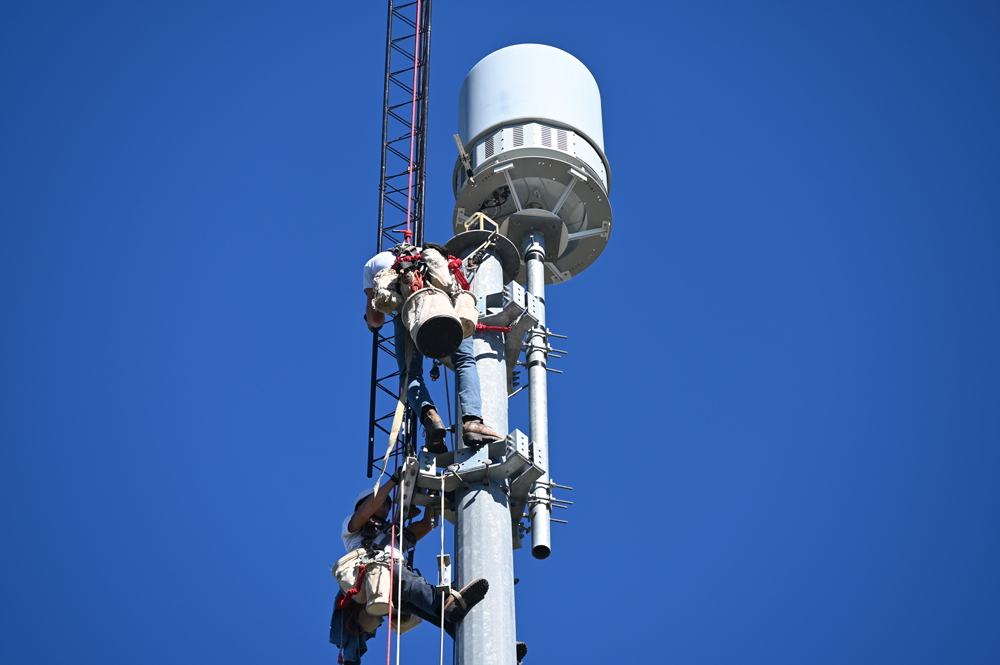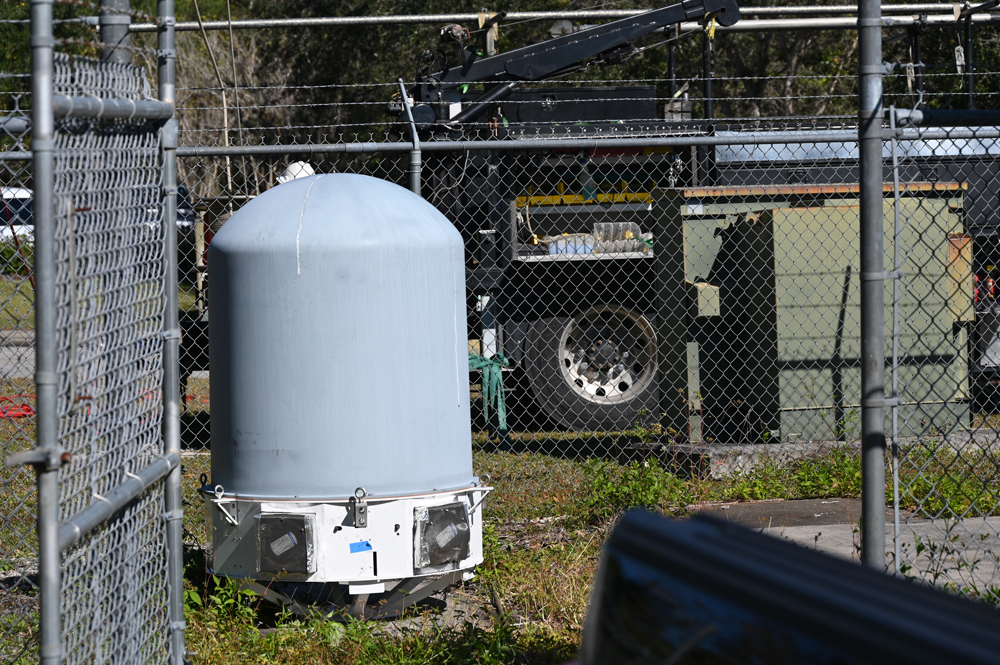
A gift to Flagler County that could save lives in weather emergencies, and that’s worth worth between $120,000 to $150,000, is sitting unused to its intended potential atop a pole in Bunnell.
Since June the 330-pound radar has sat atop a 100-foot monopole at the Emergency Operations Center in Bunnell. There are just three like it in the state: in Bunnell, in Marion and in Collier counties. The Florida Legislature approved and appropriated the cost for the three earlier this year.
It’s called hyper-local radar. It generates precise, localized weather data in a 45-mile radius that the massive radars of the National Weather Service in Jacksonville and Melbourne cannot always capture, such as tornadoes that develop close to the ground. For Flagler County, that’s a (potentially) essential improvement.
The big NWS radars are extremely powerful. But because of their locations some 70 miles in either direction Bunnell or Palm Coast, and because of the curvature of the earth, their signal inevitably ends up missing weather activity closer to the ground the further it travels from the radar itself. Flagler County had always had that issue.
“I don’t like calling it a gap, because it’s not a gap, it’s just how low the radar can get above ground,” says Flagler County Emergency Management Director Jonathan Lord. “That would allow the weather service to see lower down than they currently see in our area.” Lord is pretty sure there’s been tornado touchdowns in the county that the two radars in Jacksonville and Melbourne missed, including possibly some touchdowns during Hurricane Milton, and definitely when an early-morning tornado tore through Palm Coast’s B-Section 13 months ago.
The gray, cylindrical radar atop the monopole, handmade by Titusville-based StormQuant (it’s still not quite in te mass market), is intended to solve that issue and produce a wealth of localized weather data that the National Weather Service can then analyze and incorporate in its forecasts.
There’s one problem: until now, StormQuant’s software could interact only with Apple products. Macs. Not Windows. Not PCs. The expensive radar in Bunnell has been generating all sorts of data. It’s been stored at StormQuant. It’s been accessible by the Emergency Operations Center’s Mac in Bunnell. But it’s been all but unusable by the National Weather Service, because everything at NWS is Windows-based.
A fix is in the works. StormQuant Chief Meteorologist Howard Moore said the company has developed an interface. But it’s still not been deployed. “Our software engineers have it ready to be loaded on PC,” he said. “We’ve had it for a month, a month and a half now, we’ve had it ready, and we’ve been reaching out, but when the hurricanes came in, it was bad timing, because they were busy doing work in hurricanes. Obviously, that’s more important.” They being the National Weather Service. He said StormQuant is waiting on NWS to “to reach back out to us and tell us they’re ready to receive it. So it’s ready to go.”
It should be, otherwise it’s quite a waste of what could be an extremely valuable resource, if not a life-saver, since it would enable the triggering of more precise tornado warnings that, if closer to the ground, would not have to rely on storm-spotters.
It’s an even bigger waste of resources since today, StormQuant was in Bunnell, swapping out one radar for another. The new radar is more powerful than the previous version and less prone to “loss of signal,” Moore’s rds. He who was supervising the swap from the ground. It was a high-wire act as two crew members tethered to the top of the 100-foot pole built a crane at the very top that rose perhaps 15 feet higher, allowing them to lower one radar and lift the other into place.
StormQuant is working in partnership with the Florida Division of Emergency Management. The partnership provides Emergency Management with 10 licenses for access to the weather data. Those licenses can be distributed to the National Weather Service, the Federal Aviation Administration and other users. It’s a three-year contract, during which the state will evaluate the effectiveness of the three hyper-local radars in the three counties.
“These locations that they chose were because of the gaps,” Moore said, using that word Lord doesn’t like. “There was a corridor in the kind of more northern part where we are, Flagler County, as you go west across the state toward Marion County. And then there’s also a corridor more in the south. And that’s why the one is in Collier County. Those corridors are where you see more of the gaps in both the verticals and the horizontal gaps in data. And that’s where they’ve noticed that they had some issues in the past with some of the Weather Service forecasting, watches and warnings. And they said, Hey, maybe this could help that. And so that’s why we were told FDM chose these locations.”
FDM, the Florida Division of Emergency Management, chose the locations. The state emergency management director, Kevin Guthrie, used to be the local emergency management director before Lord, so he is closely familiar with the the weather activity that could be missed by the larger radars in Jacksonville and Melbourne. The monopole near the EOC is a prime location not just because of EOC, but because it has its own power back-up system and was ready to go. EOC was not using the monopole.
![]()





























Let it burn says
The republicans don’t believe in science they believe a rapist conman instead. Don’t let people know we already surpassed the 1.5 degree goal on our way to 10c according to science( humans be dead after 3 or 4) enjoy the show…
Chris Maull says
HUH !
Celia Pugliese says
TY Pierre’s Flagler Live for the editorial otherwise we will proceed with our ignorance. This is why radars are so important. I am wondering still how the local Flagler FINN Airport with so many thousands low, touch and goes practice by “world wide student pilots” can be allowed from a radar less airport! The residents on the ground exposed to danger and 750 lbs of lead a year to breath.
Skibum says
Celia, Air Traffic Control (ATC) radar, which identifies and controls aircraft by the use of specialized radar, is completely different from weather radar that this article references. This new weather radar dome doesn’t look for, nor can it see, planes in the sky. It is designed specifically to see rain, lightning, rotations from hurricanes and tornados, hail, snow, wind, etc. This weather radar dome at the EOC will NOT in any way be of any use to airport towers in Palm Coast or Daytona to monitor planes taking off or landing, although it may eventually assist local airports in identifying and monitoring incoming severe weather so they can alert pilots of dangerous weather conditions.